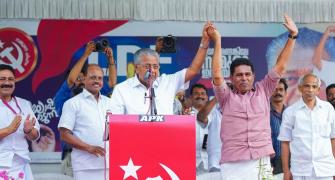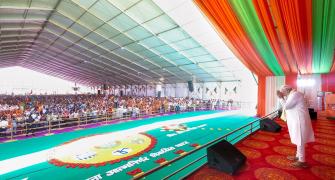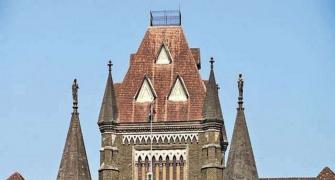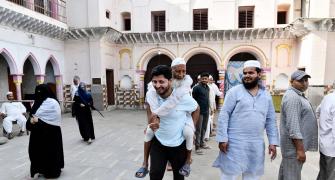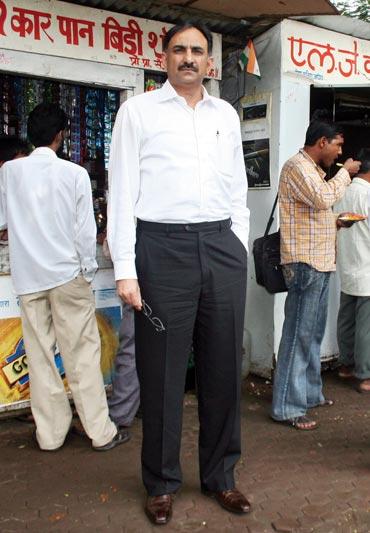 Senior Earth Institute economist and Dr Nirupam Bajpai is a global vagabond. He flits between the Big Apple, interior India, Mumbai, New Delhi and other developing countries in Sub-Sahara Africa and Asia, faithfully collecting endless data to feed his continuous research on improving developing economies. His special beat: Any of India's 600,000 varied villages.
Senior Earth Institute economist and Dr Nirupam Bajpai is a global vagabond. He flits between the Big Apple, interior India, Mumbai, New Delhi and other developing countries in Sub-Sahara Africa and Asia, faithfully collecting endless data to feed his continuous research on improving developing economies. His special beat: Any of India's 600,000 varied villages.
Bajpai, 47, along with Earth Institute Director Jeffrey Sachs and their team, have been informal advisors to three successive Indian governments since 2000 - the Atal Bihari Vajpayee-led National Democratic Alliance, and the two Manmohan Singh-led United Progressive Alliance governments - counseling on creative ways to scale up India's rural health and education services, apart from advising state governments on projects ranging from carbon capture to fiscal reform. Bajpai, who graduated from Lucknow, Uttar Pradesh, and who put in a number of years at the Massachusetts Institute of Technology and Harvard, is the director of the South Asian Program at Columbia University's Earth Institute.
In March, the Earth Institute announced plans to open a multi-disciplinary global research centre in Nariman Point Mumbai, which Bajpai will direct when it opens in September. Solving India's development issues evidently drives the soft-spoken Bajpai.
In an interview with Vaihayasi Pande Daniel, the developmental economist describes how India can improve delivery systems in its health and�education sectors
He talks passionately and idealistically about how to improve delivery systems for health centers and schools for the vast population of rural poor. His devoted interest�in India, he says, is fuelled by the fact that, when it comes to development economics, all the action is happening here and also, in spite of the years spent away, he feels "integrated" with his home country. Bajpai strongly believes there is a very positive future in store for India.
How do you connect with India and keep your finger on the pulse of what is happening here developmentally?
Typically, I am here at least five times a year. For four to five days at best. But I make one trip in the summer, when the university is closed in the US. Then I spend about a month-and-a-half and I do my own research. We do a lot (of) advising. But you do not want to do advising without your own research. We see things. We talk to people. We do our own research. We collect our own data. We analyze. And then during the course of the year we write our relevant reports, which we then present to the (Indian) policymakers over the next year.
So the other four trips are all advisory in nature. Yet they are dependent on that month-and-a-half of field research that you do in order to feedback into the advising process.
That's typically a year's travel schedule for India alone, but then there are travels in Africa and other places as well.
You interact with both the federal government and state governments regarding education and health. How is India progressing when you look at it from a state government level? And how much progress is being made in improving health and education by Indian states?
Health is a state subject. So you can only do so much in New Delhi. All the action is in the state. Education is not (only) a state subject but it is what is called concurrent - it is between the federal government and the state. So the Centre can at least have some role. But in the health sector it is entirely up to the state government. Whatever Delhi is doing in the health sector is sort of additionality.
Our latest report for the government evaluates the National Rural Health Mission (a government scheme focused on providing health to rural households with special focus in 18 states). In these sectors unless the state governments take the initiative, have the drive, have the vision, put in the resources, put the right structures of management, this is not going to work. Primarily because of the phenomenal size of people one is talking about.
For example Uttar Pradesh has close to 200 million people. If you look at the global population right now, Uttar Pradesh is probably the fourth largest country in the world, if it were to be a separate country. There is China, India, the US and UP! It has a larger population than Brazil. More than Indonesia.
So first of all are the state governments equipped? And do they have the drive, the vision or the resources and the political will to work in areas that have been long neglected? Fortunately, the National Rural Health Mission has provided the necessary framework and a fair amount of money from New Delhi to the state government to say, 'Here is some money for you, here are some objectives we want you to meet and here is the flexibility for you'.
Delhi, to my mind, does not dictate all the terms. It does in terms of some broad framework. But the NRHM has provided a fair amount of flexibility to the states to design things on their own depending on their local needs. The bottom line is how do you ensure that a man in a remote village has access to basic healthcare. This is all we are trying to achieve. It is not cutting-edge medicine. It is not cardio-vascular, it is not hypertension, it is not diabetes, it is basic healthcare. How does a woman have a safe delivery? How do you ensure that the infant doesn't die? How do you ensure that the mother doesn't die? Unfortunately India has not done enough in this area for the last 60 years.
India spends about a little over one percent of its national income on public health - this is one of the lowest proportions in the world. For a country of a billion people you can't run a public health system with that sort of money. You have to put more money, more resources in the pot. And then allow the states actually to use it - some states will surge ahead for sure. For example, among the states that are relatively better off, Tamil Nadu is much ahead in that game. Karnataka will catch up. Maharashtra will catch up with Kerala. Not with the others.
Then there is the bigger question of Uttar Pradesh, Madhya Pradesh, Rajasthan, Bihar, Jharkhand, Orissa and Chhattisgarh - these are the laggard states. So they need much more in terms of resources and technical advice. I am not very sure at the state level in these states whether these government institutions are geared up to face these challenges on the scale that they have to.
In post-Independence India this is the first time that public health in the rural areas is being given so much attention and all credit to the government.
Have you encountered situations where funds are not used and returned when it comes to education and health care?
That is one of the most disappointing things. On the one hand we are fighting with the government to put in more resources. Then, to a certain extent, the government has agreed to put in what is called untied money for every level of health facility. Like for every sub-center (the first contact point between the primary health care system and a community. One sub-centre is established per groups of 5,000 population in plain areas and 3,000 population in hilly/tribal/desert areas) which is the lowest level (of health facility in the country), there is Rs 10,000 per year which is untied. They can use it for anything they want. Then for primary health centres, which is the next level, there is a certain amount of money which is again untied. The highest level, the community health center, again has a fairly sizeable amount of untied funds.
But at the sub-centre level, the usage of resources is usually fairly good. Its usage is dependent on an auxiliary nurse/midwife, who is stationed at that sub-centre. She takes the decision for what she needs and she implements it along with the panchayat (village community). That process is doing very well. Probably there is a need to give her more than Rs 10,000 per year.
We have found problems at the PHC level, which is the second level. The medical officers or doctors, who are in charge of using that money have not been using it. Not in all places but in some. Rajasthan, for sure, is one of the states where a large part of untied money is not getting used.
Their answer is interesting. They say: 'If we were to buy say item x, my superior might ask me why I did not buy item y. In order to avoid that confrontation, in the first place, I am better off not buying either x or y.' They don't want to make a decision. If they don't use the money, nobody is going to question it. Nobody questions why money wasn't used. The whole idea of untied money is to use the money depending on the needs of your health facility. If you have a stethoscope, but need a couple of blood pressure instruments, you can buy them. The idea of untied money is that you are not restricted. But if you don't use it at all it just completely defeats the whole purpose.
We (have subsequently) suggested, for every facility - whether a sub-center or a PHC or CHC - the government should have a chart painted on the building of the clinic saying every facility should have these things and that should be standard. So if you were to buy something from that list nobody could question you and at least every facility will have these items.
So it is the small, strange practical issues that affect the smooth running of a good health scheme? The micro-level implementation issues?
We don't want to micromanage each and everything. Sometimes it comes down to that. Things like this have to be looked into. People have to go out and see why there are roadblocks. And try to counter them. There is a need for much better control or what we call control and oversee. Somebody has to be watching over and actually reporting what is happening. One of the reasons why public health has not worked in India is because there is virtually no control or oversight.
Everything is on paper, x, y and z. Everything is filled out. In terms of the paperwork everything is fine. But when you go out actually in the field, it is very different. Hence the critical importance of going out and seeing for yourself what's happening. This report (Improving Access and Efficiency in Public Health Services) is primarily dependent on two things. One of them is field visits. We have done extensive field visits in nine states, with three states being in high focus.
In nine states of India we have seen for ourselves what is happening. We go there without the government. We will not go there with the government. The moment you go there with them, it is a whole different story. You go out and search for the sub-center, search where the PHC is and just land up. And see (the situation) for yourself. Talk to the doctors. Talk to the patients. Talk to the panchayat members and get a view of things first hand.
That must be a very tough job but also very enjoyable and interesting
The one thing that I have always wondered - and thought India should have more (of) - I had the opportunity to see in Tamil Nadu in 2005. While driving, as usual, to locate some school or a PHC, we came to a place where about 100 people were really shouting in Tamil. I asked the driver, who was our translator, to tell me what was going on. He said, 'Well these guys are actually shouting because the doctor has not shown up for two days here. This is the clinic.'
So I said this is exactly what you want!
The issue is that people on the ground need to demand these services like they were doing that day. That is exactly what you want to see in UP and Bihar and Rajasthan. You see that in Tamil Nadu, where the literacy levels are relatively higher. But that is not the case up North. So I talk to farmers, small shop owners and ask them, all the time, what they ask of their politicians, when they come seeking votes. 'Do you ask them for anything, if at all you ask? Or do you just hear them out?' They say: 'Well, sometimes we ask them, but most of the time we don't.' So we say: 'You should! You should ask them what happened to my school? Why isn't the teacher showing up? Or why isn't the midday meal working properly? Why is the water supply not proper? These things, unless you ask and demand and force it, are unlikely to come through, very soon and this has to happen from bottom up.'
It turned out that the doctor in that village in Tamil Nadu was actually sick. He wasn't absent. And we got the word that he would come the next day if his fever had come down. He was running like 104! So the doctor (around there) actually had to show up because in two days the people were up in arms.
In Bihar, the doctor may not come for a week and still people may not complain.
Yes, most people will not. That is the trend (of complaining) you want to see in the laggard states. That comes only with awareness and literacy. It will take a little while before that happens. But this is the first time I have seen anything of this sort anywhere in India.
What, in a nutshell, are the most pressing issues that need to be addressed in rural education and rural public health in this country?
In rough terms, India spends about $10 per capita per year on public health. Ideally that should be about $40 per capita per year. Obviously it will not happen overnight. But what we hope is that over the next seven to 10 years, with India growing at higher rates, there will be more resources available within the government to spend more on health. Or spend more on education. For the time being, every year the allocations for public health and especially for NRHM should be stepped up to the extent possible. Another problem with India's health systems at present is that there isn't enough effective health management. At the village, block, district and state levels you need to have effective health management. We haven't ever had a health management structure.
The NRHM is trying to put this in place. But it has to be speeded up. Right now it is the medical officer or doctor who is managing the clinic. A lot of his time is spent on paperwork. He is not actually doing what he is supposed to do. He is supposed to diagnose. The doctor should not be managing the health system. He should be checking patients and doing what he is trained to do. You should have (other) people to look after the management. The third thing is that the NRHM proposes that the panchayat should own, manage and control these health services. This is very good and the right direction for our health program.
India is a very large country and you cannot think of managing these structures from the state capital. They have to be managed from the ground where they are located. The problem really is: Have you trained these people to do it? That is an area where not enough has been done and much more needs to be done for several reasons. These panchayat members are themselves not health experts. They are local people who get elected to the panchayat. They need to be trained. They are elected people and so next year maybe you have a different set of people. The training has to be an ongoing process. It is a long-term exercise but the NRHM has not done enough. It is a challenge and needs to be addressed on an all-India scale, for sure.
Another problem is that NRHM has (brought about) a surge in demand for public health from ground up. But do you have the clinic geared up to meet that demand?
Number two, a lot of the demand for the public health facilities is coming from expectant mothers. There is a scheme (by which) the government gives expectant women money if she delivers in a clinic - the Janani Suraksha Yojana or the JSY. JSY, along with the community health worker, called Asha (Accredited Social Health Activist), are creating awareness (for this scheme). This awareness, created by the Asha, and because of the JSY's conditional cash transfer, has brought about, suddenly, a huge surge in institutional deliveries. A lot of women, who were initially delivering at home, are now delivering in a clinic.
Is this more so in the 'forward states' where medical health services are better?
No, this is actually happening all over. Uttar Pradesh is showing a tremendous rise in institutional deliveries. Bihar is showing a tremendous rise. Assam too. But the question is: Do the clinics have the facilities to handle this surge? Several things are needed. The clinic maternity rooms would not accommodate more than three women at a time. Suddenly you have five women. Two are lying on the floor. If there are too many women there will be a tendency to get them home within 24 hours of the delivery, which is defeating the entire purpose. And it actually might create problems for the mother and the child should they be sent home so soon.
We have said that a woman should not leave the clinic before 24 hours and ideally close to 36 hours after delivery because only by that time you have taken care of some of the basic things. And there is the question of post-natal care, immunization and all that. It will defeat the purpose if you send her home so soon. These are some associated problems arising because initially there weren't so many institutional deliveries.
There are number of other issues. We are trying to see how we can integrate health and nutrition. One of the recommendations is that the PM chairs an inter-ministerial group which comprises the minister of health, the minister of women and child development, the minister of panchayati raj, the minister of rural development, the minister of agriculture - you need all these actors to come together - so that some national guidelines are issued from the inter-ministerial group, keeping essentially the nutrition issue in mind.
India in the next five to 10 to 15 years will have serious issues to deal with unless it integrates health and nutrition properly. You have to have another body that monitors the progress once the decisions are taken because ultimately everything has to come down to the village level right from Delhi in order to become functional and India has more than 600,000 villages. This is something that will take some time to trickle down and that process has not started.
And the main issues bogging down rural education schemes?
On education, because of the Sarva Shiksha Abhiyan, launched in 2001 (the flagship programme pioneered by prime minister Atal Bihari Vajpayee that promises education for all), the government has actually established schools in virtually 90 plus percent of habitation in the country. These are probably (just) two-room schools with one teacher. But that is all right.
For a start you cannot expect to have full-fledged schools. You don't have the resources. The challenge now is: what is happening in the schools? I have been propagating and trying to push the idea that not only do we need to provide a nutritious midday meals but we also need to provide a school breakfast. For the most part the children remain. You can't expect children to really learn and retain anything if they are hungry. So the government could provide them some nominal breakfast.
We are not talking about anything elaborate: A banana, a couple of cookies, half a cup of milk. I think that should be a good enough to start with.
In India, of course, you are talking about such large numbers so when you add it up it really becomes a sizeable amount. But it will be really very, very worthwhile. In education there are other critical issues. The government provides free books for kids but unfortunately the people who design those books have very little sense of what these kids in a public school in a rural setting can really understand. There is a big disconnect between the schoolbooks and the skill or understanding level of these kids.
I strongly recommend that whoever writes these books should actually revisit the issue and should go himself/herself to these places and see for themselves how much of an understanding these kids have.
At the grassroots level, do you feel India is making progress? Is India's prosperity being reflected through and through? Is India making strides from village level up?
I am a development economist. So I am looking at it from the point of view of how India is developing vis-a-vis the rest of the developing world. And where is it likely to be headed. Are the government's investments and priorities in line with where they should be? Against that background, I would think, India's biggest areas of focus, to my mind, are water, health, education, infrastructure (power, roads; telecom we have done great so I don't have anything to say on the telecom front). On all these other issues, I think, in the last 10 years or so generally India is in the right direction. That includes (the direction taken by) the previous government and (looking at India) through and through.
Jeff Sachs and I wrote a paper in 2000 called 'India's Decade of Development'. We said that the first decade of the 21st century was very likely to be India's decade of development. And that a lot of things are likely to happen in all of these sectors I mentioned earlier and that India is likely to grow at very high rates, so that by the end of the decade there is a very strong likelihood that we will double our per capita income.
India was pretty much on course - unfortunately because of the global financial crisis we dipped. We will not be able double our per capita income but we will come pretty close to that. While on the one hand the country is growing at a high rate it is critical to take the additional resources the government has and put them into these sectors mentioned. (For the rest of the sectors) there are resources. There are lobbies. There are interest groups. Here I am talking about the (sectors that affect the) 700 million in the rural areas. That is a huge market in the years to come and that's where I think a huge amount of attention and resources needs to go. That is where private sector will not invest, unless the market is developed to a certain point. That will not happen unless the government has put in the resources (initially).
So inspite of so many issues holding India back, like, for instance corruption, India is surging ahead?
Oh yes, there is no question about it.
I am pretty positive that despite all these problems - and I keep saying this - despite all our infrastructure problems, issues of corruption, governance issues, criminality in politics, this place still grows at eight-plus percent! So imagine if you were to start removing some of these constraints. We will grow at 10-11-12 percent for the next 25 years!

There is no question about it. India is driven by the domestic market. There are 250 million people in the middle class. That's what drives it. Not the global market because India's exports share to GDP is much lower relative to China. China is driven by an export market but India is driven by the domestic market. That's the beauty of it. It will go on! You cannot hold it back.
The challenge here is whether you are investing in the right sectors. These are all long-term investments. They will not give you returns tomorrow or day after. It is hard politically to take that call and put in billions in health which will not give you returns tomorrow or day after. Billions into primary education again will not give you returns tomorrow or day after. These will give you returns 15 years down the line.
I would think that Dr Manmohan Singh's government, in that sense, has definitely put the agenda on that track. (Former prime minister) Atalji (Bihari Vajpayee) announced it in his Independence day speech in 2000 � actually I was one of the (people who advised him on SSA). Health was done by Manmohan Singh's team. I think politicians realize that it is time (to put down these kinds of programmes).
So India is in good hands?
I would definitely think so. There is no question about that. For several reasons: One, of course is that I think on a certain level we are on autopilot now. States like Gujarat and the fastest growing ones, Tamil Nadu, partly Andhra, Maharashtra - they have come to a point where they don't need the government. And that is one of the reasons why it has happened. It has come to that point because you have allowed the private enterprise to make decisions and grow.
Where you need the government are in these sectors where the private sector will not work and you should sort of fill in that gap. I am completely apolitical - I don't have political visions of that sort - but I am one who works with anybody who is interested in development.
I have all respect and regard for Dr Manmohan Singh, who is such an acclaimed, internationally renowned, accomplished economist himself; doesn't need advisors. But who better then him to know what needs to be done?
I think surely India is in very good hands. There is no question. We have some of the brilliant minds working on these issues.
Nirupam Bajpai's latest book, Improving Access and Efficiency in Public Health Services: Mid-Term Evaluation of India's National Rural Health Mission, can be purchased from Sage Publications at www.sagepub.com or at www.sagepub.in
Image: Dr Nirupam Bajpai
Photograph: Satish Bodas




